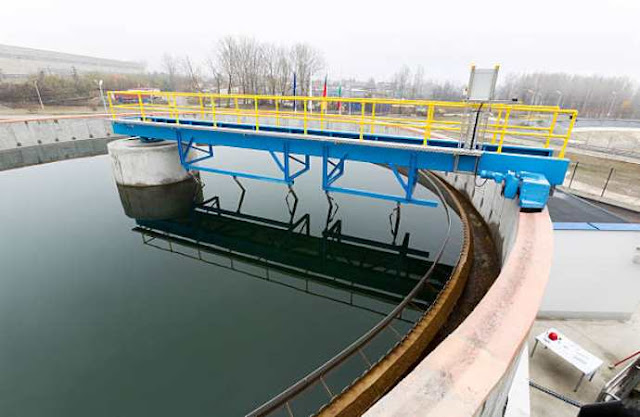Biological wastewater treatment

Biological wastewater treatment —
which is predicated on microorganisms to break down natural waste — has a protracted history, and stages from simple cesspits to conventional activated sludge flora all the manner to technologically superior answers like MABR.
Biological wastewater treatment harnesses the motion of micro organism and other microorganisms to clean water
Biological wastewater remedy is a method that seems easy at the floor since it makes use of natural processes to help with the decomposition of natural substances, however in truth, it’s a complex, no longer absolutely understood method on the intersection of biology and biochemistry.
Biologial remedies depend on bacteria, nematodes, or other small organisms to interrupt down organic wastes using normal cellular approaches. Wastewater commonly consists of a buffet of natural matter, inclusive of garbage, wastes, and in part digested meals. It additionally can also comprise pathogenic organisms, heavy metals, and pollutants.
The purpose of organic wastewater remedy is to create a gadget wherein the effects of decomposition are easily gathered for correct disposal. Biological treatment is used worldwide because it’s powerful and more reasonable than many mechanical or chemical procedures.
Biological remedy generally is divided into cardio and anaerobic processes. “Aerobic” refers to a process in which oxygen is present, at the same time as “anaerobic” describes a organic manner wherein oxygen is absent. Scientists were able to control and refine each aerobic and anaerobic biological methods to obtain the superior removal of organic substances from wastewater.
Biological wastewater remedy frequently is used as a secondary treatment system to do away with cloth remaining after primary treatment with techniques such as dissolved air flotation (DAF). In the primary water treatment technique, sediments and substances including oil are eliminated from the wastewater.
Aerobic Wastewater Treatment
Aerobic wastewater remedy strategies consist of easy septic or aerobic tanks, and oxidation ditches; floor and spray aeration; activated sludge; oxidation ditches, trickling filters; pond and lagoon-based totally treatments; and aerobic digestion. Constructed wetlands and diverse styles of filtration are also considered biological remedy strategies. Diffused aeration structures can be used to maximise oxygen switch and decrease odors because the wastewater is treated. Aeration affords oxygen to the beneficial micro organism and different organisms as they decompose natural substances in the wastewater.
A time-venerated example of an aerobic biological treatment approach is the activated sludge system, that's extensively used for the secondary treatment of each home and business wastewater. It is nicely acceptable for treating waste streams high in organic or biodegradable content material and is often used to deal with municipal sewage; wastewater generated by way of pulp and paper turbines or meals-related industries which includes meat processing; and commercial waste streams containing carbon molecules.
MABR Treatment
In recent years, technological advances have been reworking organic processes. One example is the membrane aerated biofilm reactor (MABR), which refines this method to use ninety% much less strength for aeration, commonly the most energy-extensive level of traditional biological remedy. In Fluence’s MABR remedy, air at atmospheric strain is lightly blown into a spirally wound membrane in a tank, with air on one side of the membrane and combined liquor on the other in a single tank. Nitrification-denitrification is achieved by using a biofilm that forms at the membrane. The end result is an effluent appropriate for irrigation or launch into the surroundings.
Most legacy plants round the sector use activated sludge remedy or different older aerobic remedy processes. Such plants are time-eating and luxurious to update, or don’t have necessary area for enlargement. To deal with this want, Fluence has created SUBRE MABR modules. SUBRE submerges arrays of MABR membranes in current wastewater treatment plant tanks to increase power efficiency, capacity, and effluent quality — all on the plant’s current footprint.
Fluence has additionally packaged complete Aspiral™ MABR wastewater remedy plants internal fashionable shipping bins, which permits efficient transportation and rapid commissioning in really any vicinity. The plug-and-play units can be used in tandem to boom capacity, and are designed for low protection and far flung monitoring.
In only a few years, MABR has evolved right into a mature technology, with substantial initiatives underway in China in compliance with the u . S . A .’s strict Class 1A effluent requirements. In the US, Fluence MABR proved itself in compliance with California Title 22 effluent standards all through a yearlong demonstration at Stanford University.
Anaerobic Treatment
In contrast, anaerobic remedy uses bacteria to assist natural cloth become worse in an oxygen-loose environment. Lagoons and septic tanks may also use anaerobic strategies, but the quality-recognised anaerobic treatment is anaerobic digestion, that's used for treating effluent from food and beverage production, as well as municipal wastewater, chemical effluent, and agricultural waste.
Anaerobic digestion drives one of the maximum robust regions of aid restoration: energy recuperation. In this form of electricity restoration, additionally referred to as waste-to-energy, anaerobic digestion is used to produce biogas, which consists typically of methane. Operators can use it to generate strength to help fuel operations on the manner to come to be strength internet 0, or maybe flip waste streams into sales streams.
Further Treatment
The sort of biological treatment selected for wastewater remedy, whether or not aerobic or anaerobic, depends on a wide variety of factors, consisting of compliance with environmental discharge great policies.
Biological remedies often are supplemented with extra treatment tiers, inclusive of chlorination and UV treatment, in addition to a number of filtration options which includes carbon filtration, reverse osmosis, and ultrafiltration.
Researchers retain to search for ways to optimize traditional organic wastewater remedy. In one example, Finnish researchers added iron sulfate to wastewater before biological remedy to reduce phosphorous in hard-to-treat pulp mill wastewater. Other researchers have used UV mild to eliminate challenging materials including chemical residues and pharmaceutical compounds. And, MABR’s groundbreaking aeration version saves a lot power that it makes remedy viable in far off areas on opportunity strength sources.
So, while organic remedy has a long history, it’s continuing to evolve in methods that make it extra effective, green, and available. Contact Fluence for information on our MABR products or to take gain of our 30 years of enjoy in waste-to-strength answers.@ Read More minisecond


